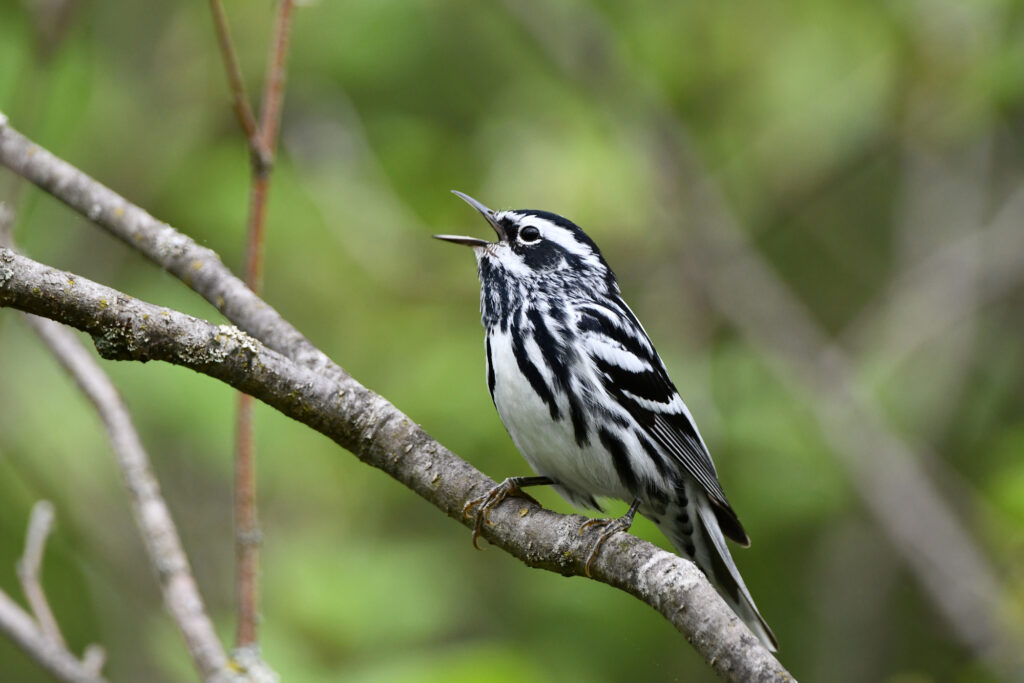Kansas, or the Sunflower State, is known for its various habitats, making it the perfect home for many bird species. With 5.2 million acres covered in forests and five incredible national parks, Kansas is home to about 225 bird species that occur regularly.
In this article, we’ll talk about some of these amazing creatures and what makes them so attractive to bird watchers. So, keep on reading.
Red Birds in Kansas
Northern Cardinal
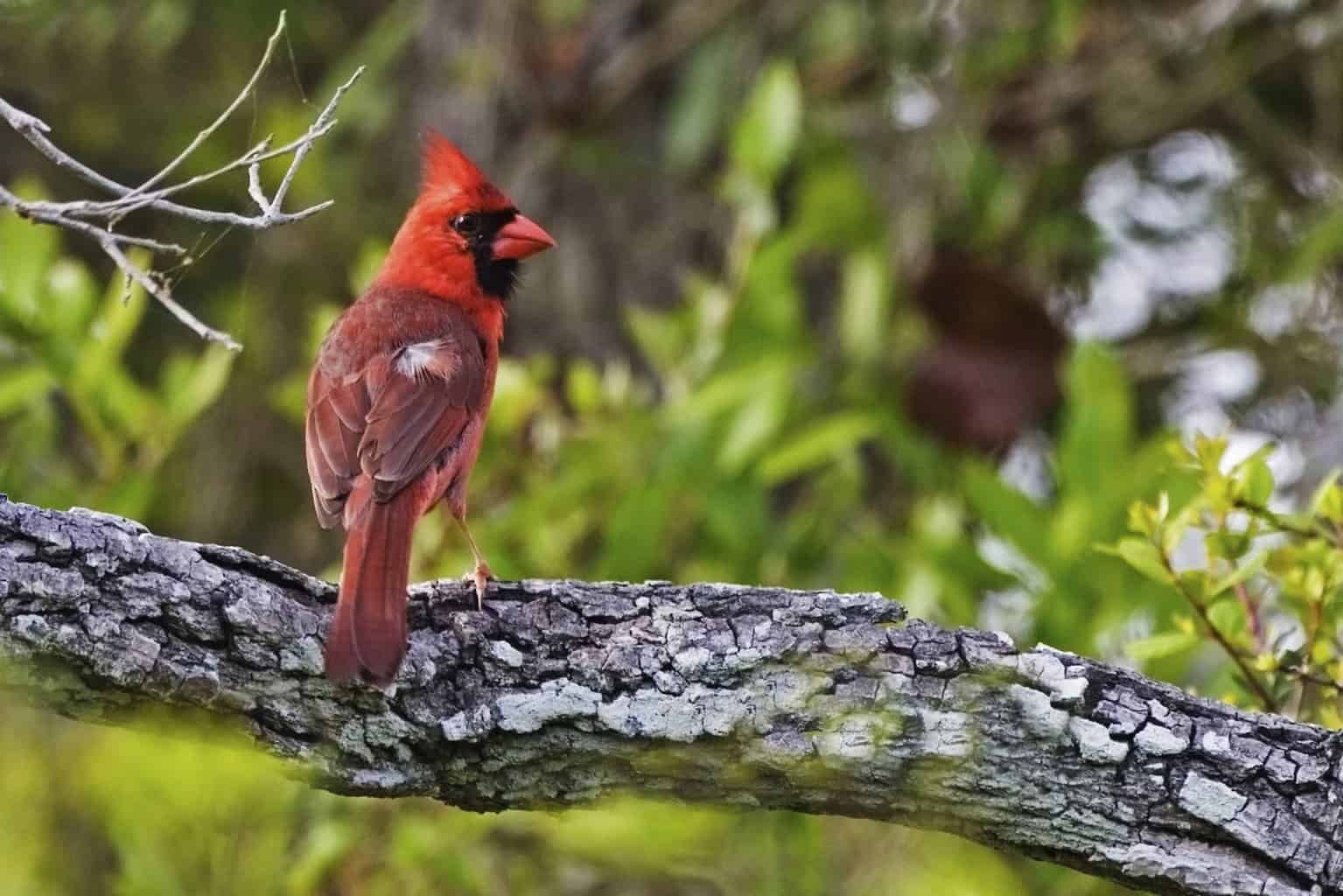
- Scientific Name: Cardinalis Cardinalis
- Length: Between 8.3 and 9.1 inches
- Weight: Between 1.9 and 2.29 ounces
- Wingspan: Between 9.8 and 12.2 inches
Additional Information:
Common in all Kansas counties, the Northern Cardinal is one of the biggest songbirds that you can see. It’s easily known thanks to its rather big bright red body and the black feathers that surround the bill and is one of the most popular birds of its kind.
The Northern Cardinal is probably one of the first birds that a beginner birdwatcher might encounter. It’s also a regular guest in your backyard if you install a platform feeder.
Northern Cardinals feed on fruit, insects, and seeds. The males are known to have the potential to become extremely aggressive birds, even attacking their own reflections in a glass window. So if you think that the bird is knocking on your window because it wants to be let in, you’re mistaken.
Pine Grosbeak
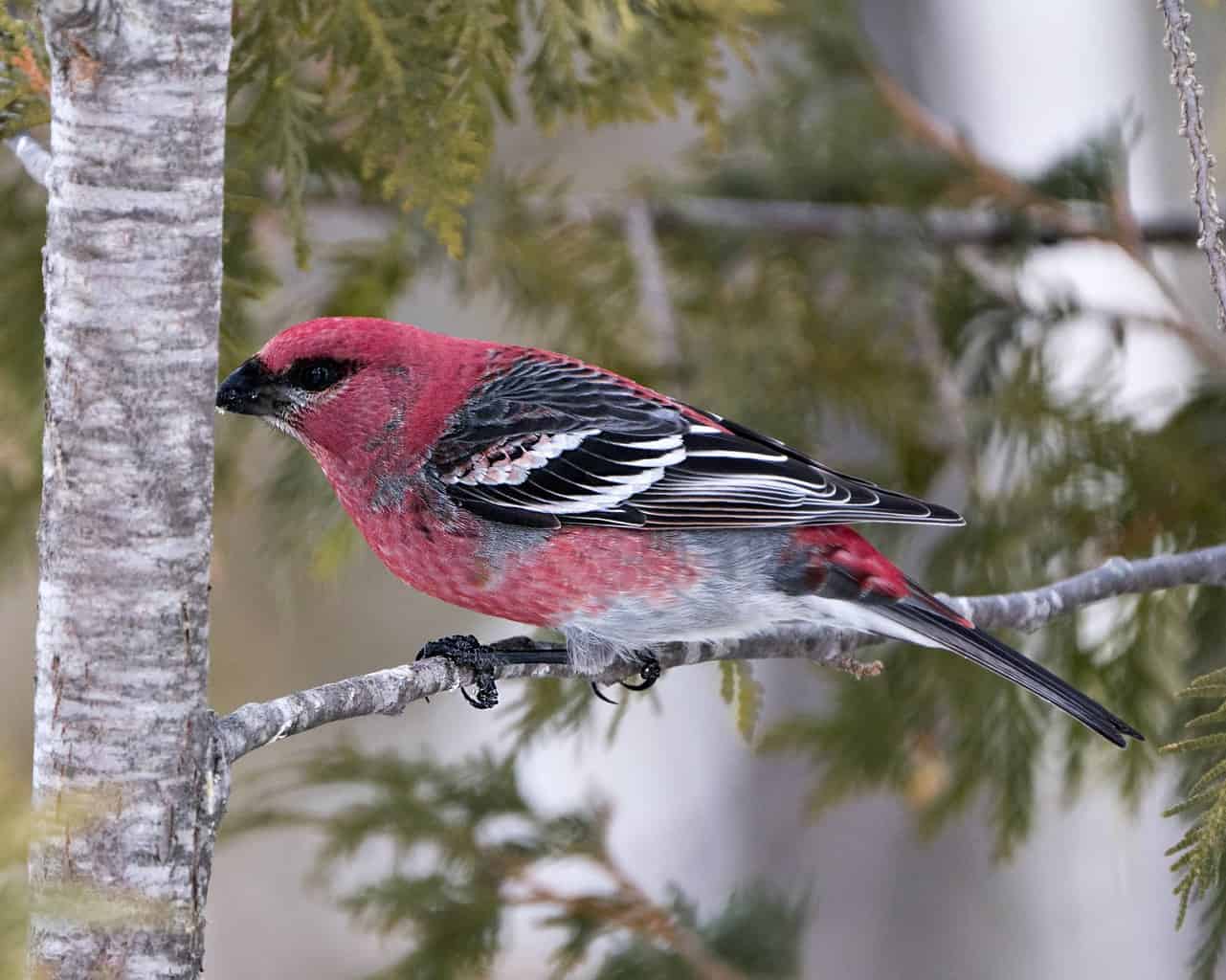
- Scientific Name: Pinicola Enucleator
- Length: Between 7.9 and 10 inches
- Weight: Between 1.8 and 2.8 ounces
- Wingspan: About 13 inches
Additional Information:
This heavy-chested finch has a slightly longer tail and reddish pink and gray plumage. Female and young Pine Grosbeaks are grayish birds with some reddish or orange tints.
The birds feed on buds, seeds, and fruits, and they also catch insects in the warm summer months. The parents regurgitate a paste of insects and vegetable matter to feed their young.
The Pine Grosbeak is usually seen hopping on the branches to feed on the fresh buds or on the ground to catch a fallen seed.
You can attract this cute bird to your backyard in the winter by setting up a feeder and filling it with hulled sunflower seeds or black oil sunflower seeds. Due to their size, a tube or platform feeder will work best.
House Finch

- Scientific Name: Haemorhous Mexicanus
- Length: Between 5 and 6 inches
- Weight: Between 0.6 and 0.9 ounces
- Wingspan: Between 8 and 10 inches
Additional Information:
The House Finch belongs to the red birds’ category, although the male birds are the ones that have red faces that make them easily recognized. Female birds are rather gray-brown.
The beak is long compared to the head, and the wings are short. It’s a famous bird that you can find in city parks, parking slots, farms, and forest edges.
The House Finch feeds on plant material, including seeds, buds, and fruits. In orchards, it feeds on blackberries, figs, and cherries. It will come to your backyard if you keep a continuous supply of black oil sunflower seeds in your feeder.
Red-Bellied Woodpecker
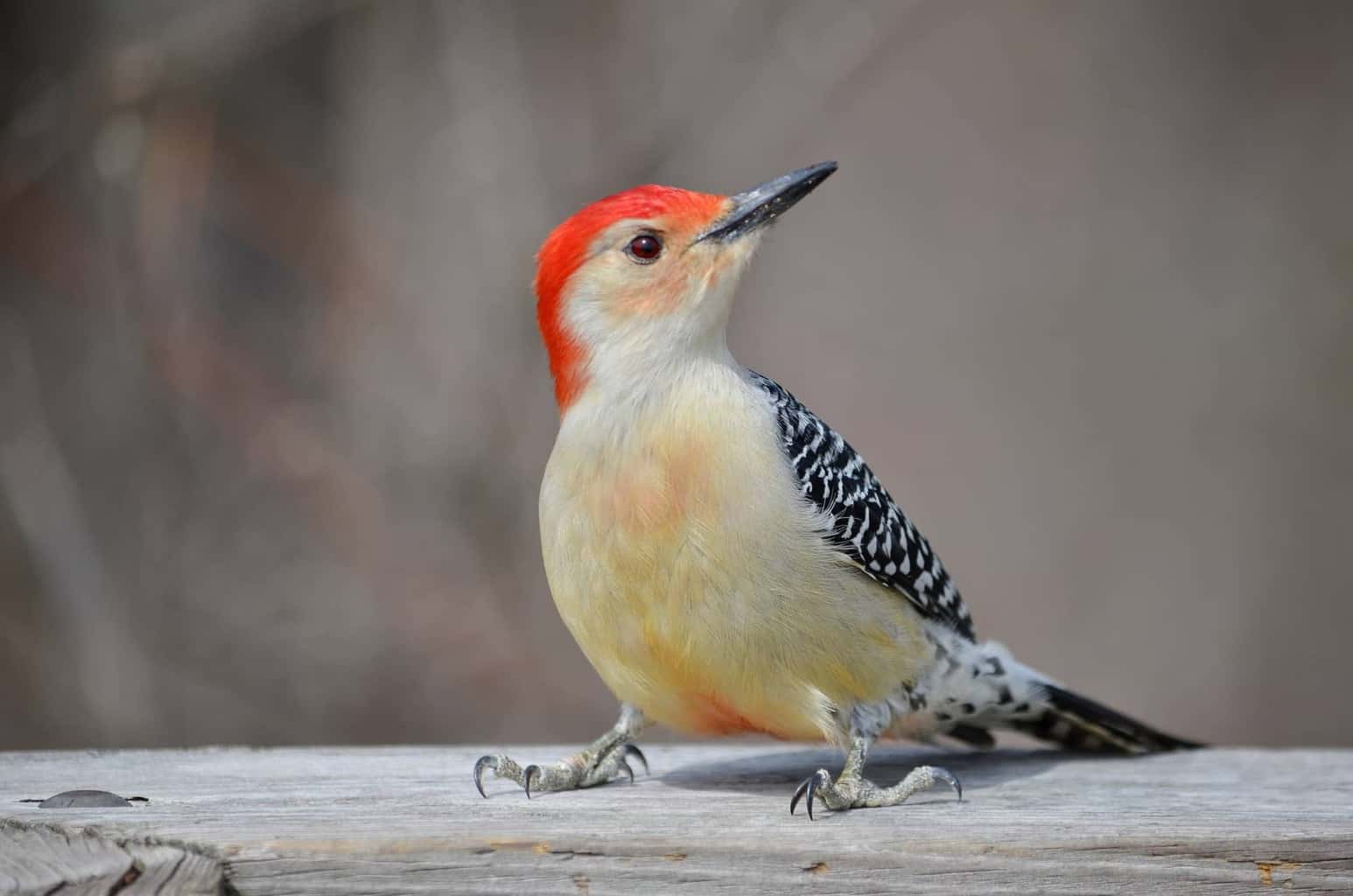
- Scientific Name: Melanerpes Carolinus
- Length: Between 9 to 10.5 inches
- Weight: Between 2 and 3.2 ounces
- Wingspan: Between 15 and 18 inches
Additional Information:
The Red-Bellied Woodpecker has pale plumage with a barred back and a bright red cap. It has a rolling call that makes it noticeable, and they are quite common birds in the woodlands. In most cases, this bird can be seen perching in backyards all year round.
The Red-Bellied Woodpecker will leave the dark forests to visit your backyard if you keep the woodpecker feeder well-maintained. It also eats plant material, insects, and spiders.
It sticks its barbed-tip tongue into the trunks of dead trees to look for larvae. The tongue tip can go up to 2 inches past the end of the beak. When food is abundant, the Red-bellied Woodpecker will hide nuts in crevices to use them later.
Hepatic Tanager
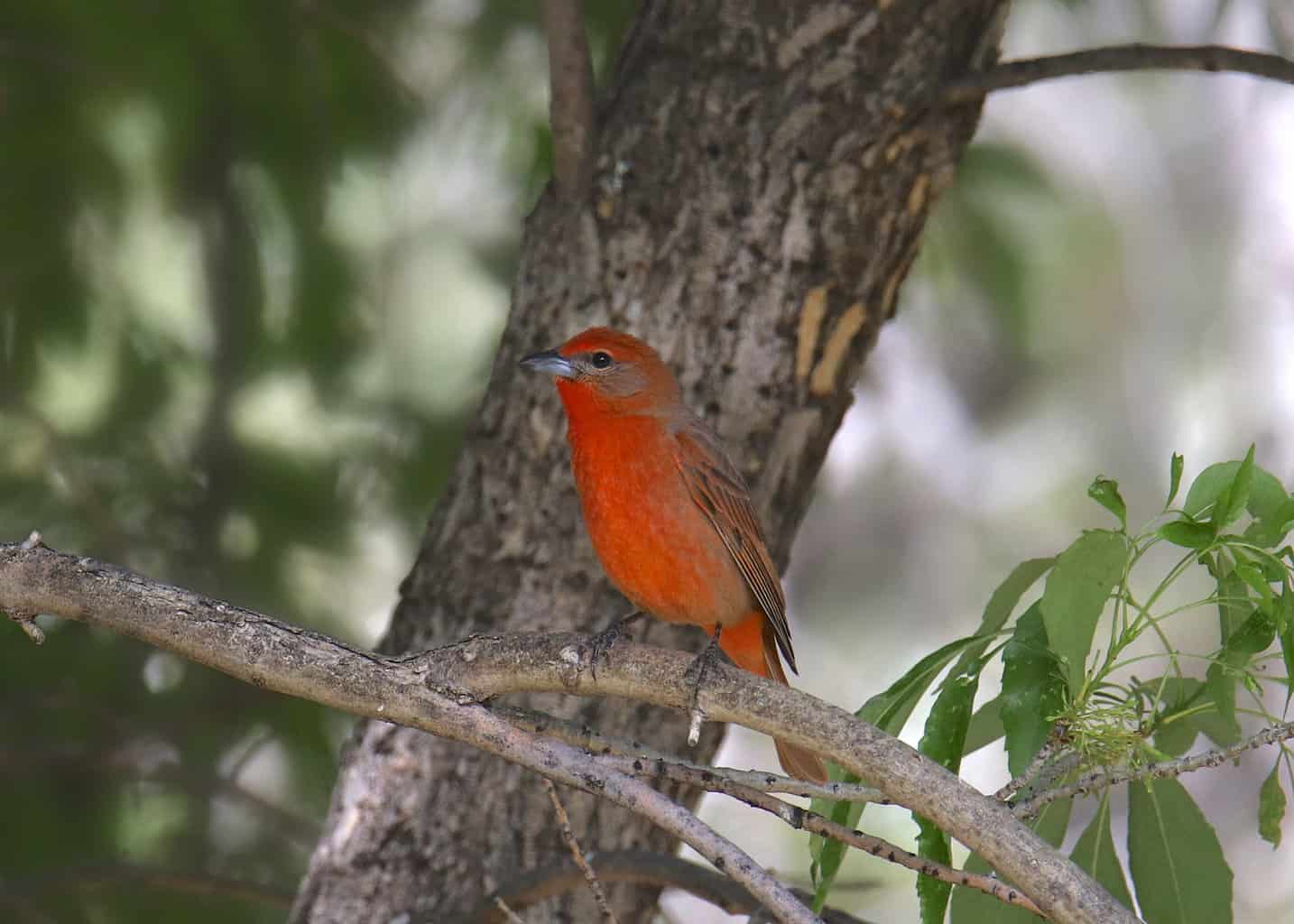
- Scientific Name: Piranga Flava
- Length: About 8 inches
- Weight: About 1.3 ounces
- Wingspan: About 12.5 inches.
Additional Information:
This songbird has strong legs, a strong tail, and powerful wings. Adult males have a red brick upper with some grayish feathers and reddish below. Female birds are olive-yellow, and the young birds look like them, but they could be paler.
Male birds establish their territories to cover an average of 3 acres. They like to sing well into the late morning.
The Hepatic Tanager’s diet is mainly made of insects like moths, butterflies, grasshoppers, bees, and ants. It hops to forage for food and sometimes can catch an insect while it’s flying. The birds can sometimes be seen feeding in pairs or groups.
Pileated Woodpecker

- Scientific Name: Dryocopus Pileatus
- Length: Between 16 and 19 inches
- Weight: Between 9 and 14 ounces
- Wingspan: Between 26 and 30 inches
Additional Information:
The Pileated Woodpecker is one of the biggest woodpeckers that you can find in Kansas, especially in the large mature forests, where there are lots of dead trees.
This bird is constantly seen drumming on trees to find the hidden carpenter ants and other wood-boring larvae. The bird’s strong bill allows it to dig big holes to forage for food.
The Pileated Woodpecker competes for nesting cavities with other birds like ducks, owls, and other types of woodpeckers. Although in some cases, ants make up to 97% of this bird’s diet, it can be seen in backyards if you have a bird feeder filled with suet in winter.
Blue Birds in Kansas
Eastern Bluebird

- Scientific Name: Sialia Sialis
- Length: Between 6.3 and 8.3 inches
- Weight: Between 0.95 and 1.2 ounces
- Wingspan: Between 9.8 and 12.6 inches
Additional Information:
The Eastern Bluebird can be easily found in several counties in Kansas throughout the year. Male birds have beautiful sky-blue heads and rusty chests, while female birds have paler bodies with grayish-black plumage and blue feathers on the tail and wings.
The Eastern Bluebird lives in meadows surrounded by trees that represent a good location for building a nest. The birds can often be seen perching on wires and low branches as they scan the ground.
This bird usually catches insects on the ground, and its main prey is usually beetles, caterpillars, crickets, and spiders. It will come to your feeder if you provide mealworms.
Mountain Bluebird
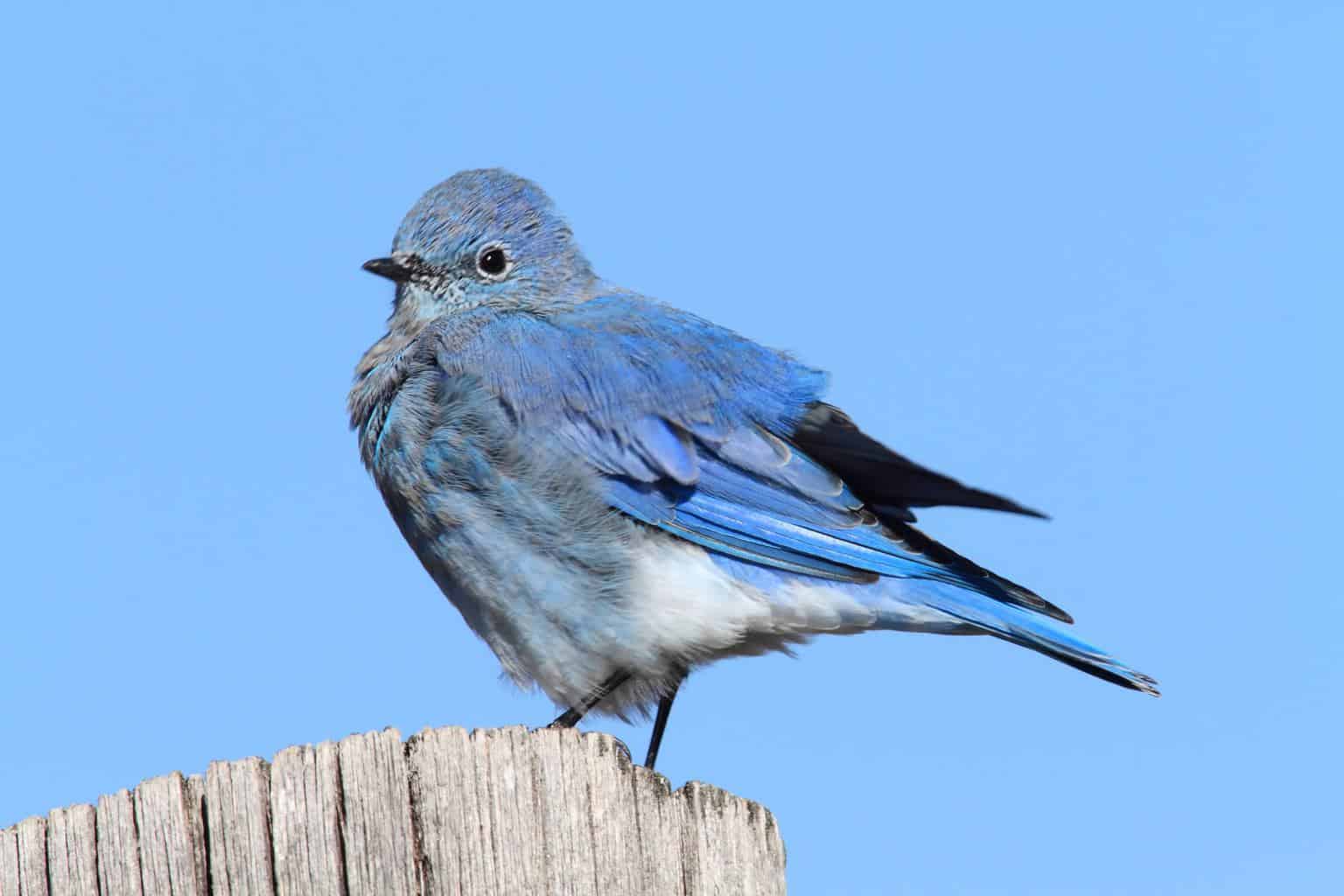
- Scientific Name: Sialia Currucoides
- Length: Between 6.1 and 7.1 inches
- Weight: Between 0.85 and 1.31 ounces
- Wingspan: Between 11 and 14.2 inches
Additional Information:
The Mountain Bluebird can be found in the open fields and woodlands of Kansas. This small migratory thrush is often seen hovering as it looks for insects.
The bird has sky-blue plumage, which is slightly darker on the wings. Female birds are usually gray-brown with some pale blue tinges on the wings.
It mainly feeds on insects during the breeding season but might complete its diet with fruits like grapes, cedar berries, and currants. If you live near an open habitat, you can attract a breeding pair by setting up a nest box.
Indigo Bunting
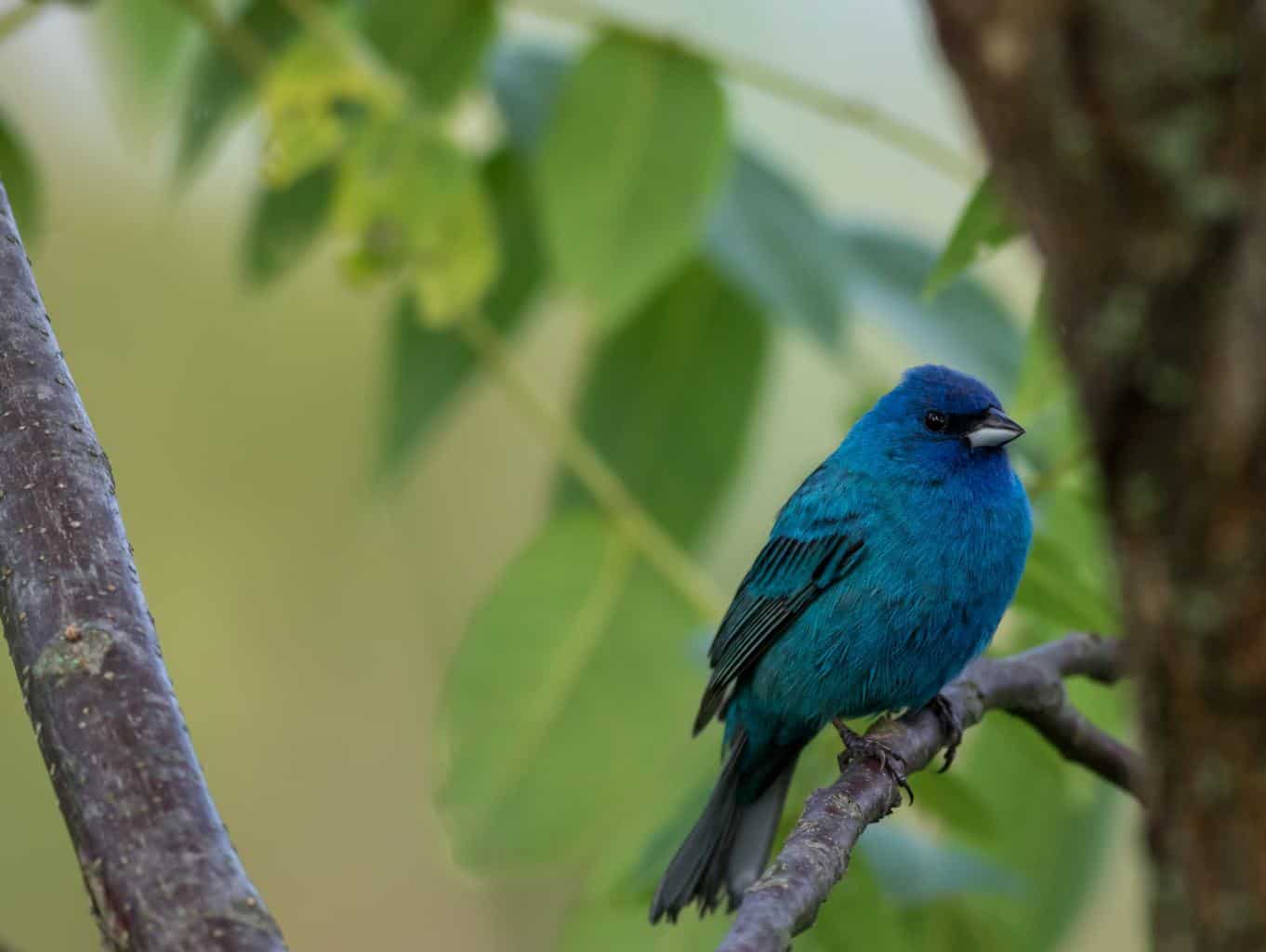
- Scientific Name: Passerina Cyanea
- Length: Between 4.5 and 5.9 inches
- Weight: About 0.5 ounces
- Wingspan: Between 7 and 9 inches
Additional Information:
Mainly found in the eastern part of Kansas, bird watchers see Indigo Buntings from April through October in the woodlands and towns. The male has bright blue plumage, with a darker head. Females are brownish with faint blue tinges on the chest and wings’ ends.
The Indigo Bunting is a small songbird that spends its time perching on phone lines, shrubs, and treetops. It forages in fields, bushy canyons, and grasslands, where it mainly looks for the small seeds of thistles and dandelions.
It also feeds on grains, berries, spiders, grasshoppers, and brown-tail moth caterpillars, which represent a respiratory hazard to most people. You can attract it to your backyard by setting up a feeder and filling it with tiny seeds like Nyjer, with occasional live mealworms.
Blue-Winged Teal
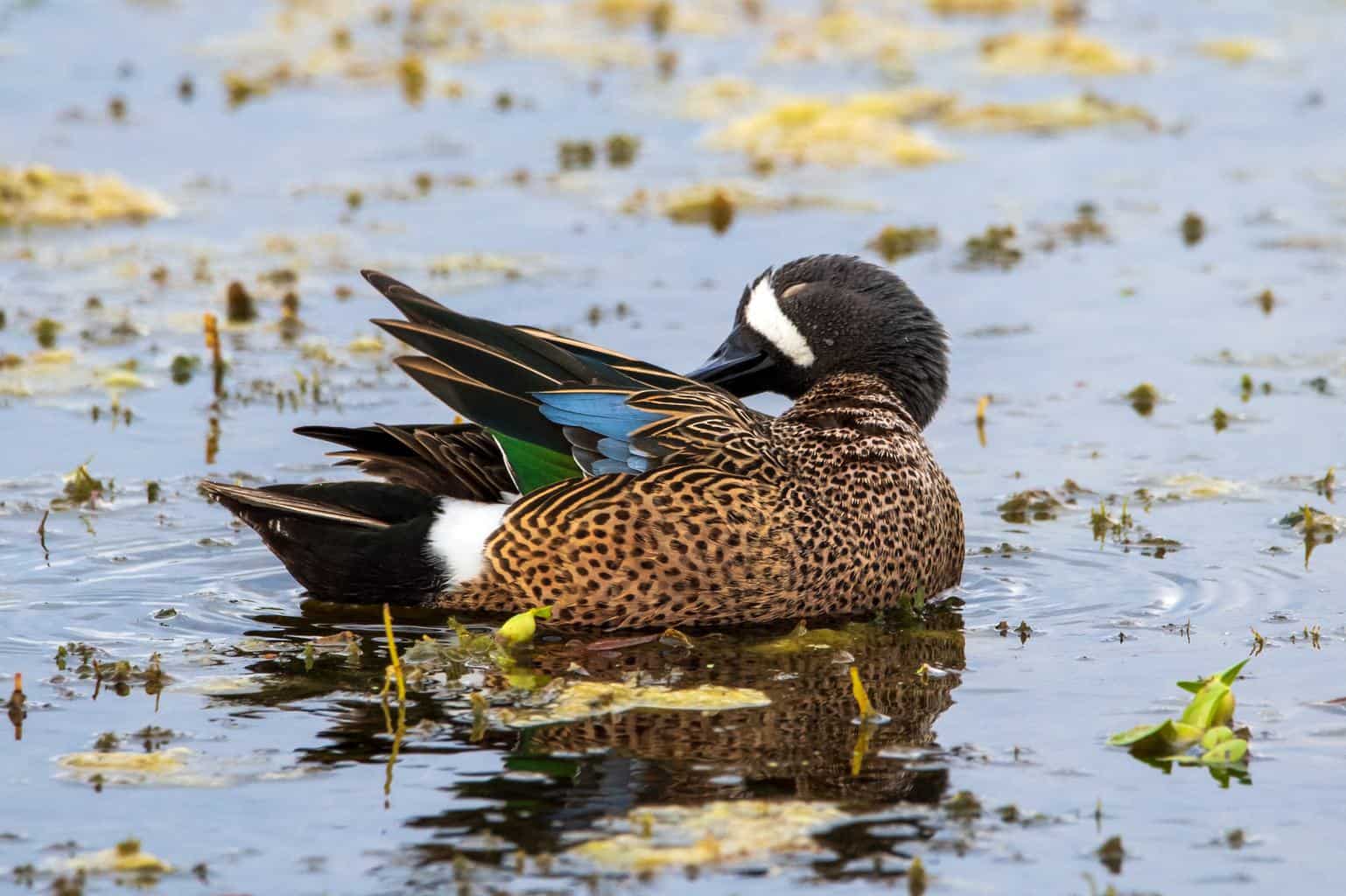
- Scientific Name: Spatula Discors
- Length: About 16 inches
- Weight: About 13 ounces
- Wingspan: About 23 inches
Additional Information:
The Blue-Winged Teal is found in the shallow wetlands of Kansas. This bird gets its name from the teal patch on the shoulders, which is only visible when the bird is flying. The rest of the body is buff-colored with black spots, and the head is blue.
This is a sociable bird that can often be found with other dabbling ducks. It often seeks a concealed spot to rest after foraging. It eats aquatic insects and vegetation. It also feeds on snails, clams, and crustaceans.
The Blue-Winged Teal likes to show off its exaggerated motion for display. The male usually engages in this behavior during the courting period. The female usually responds by lowering its head.
Belted Kingfisher
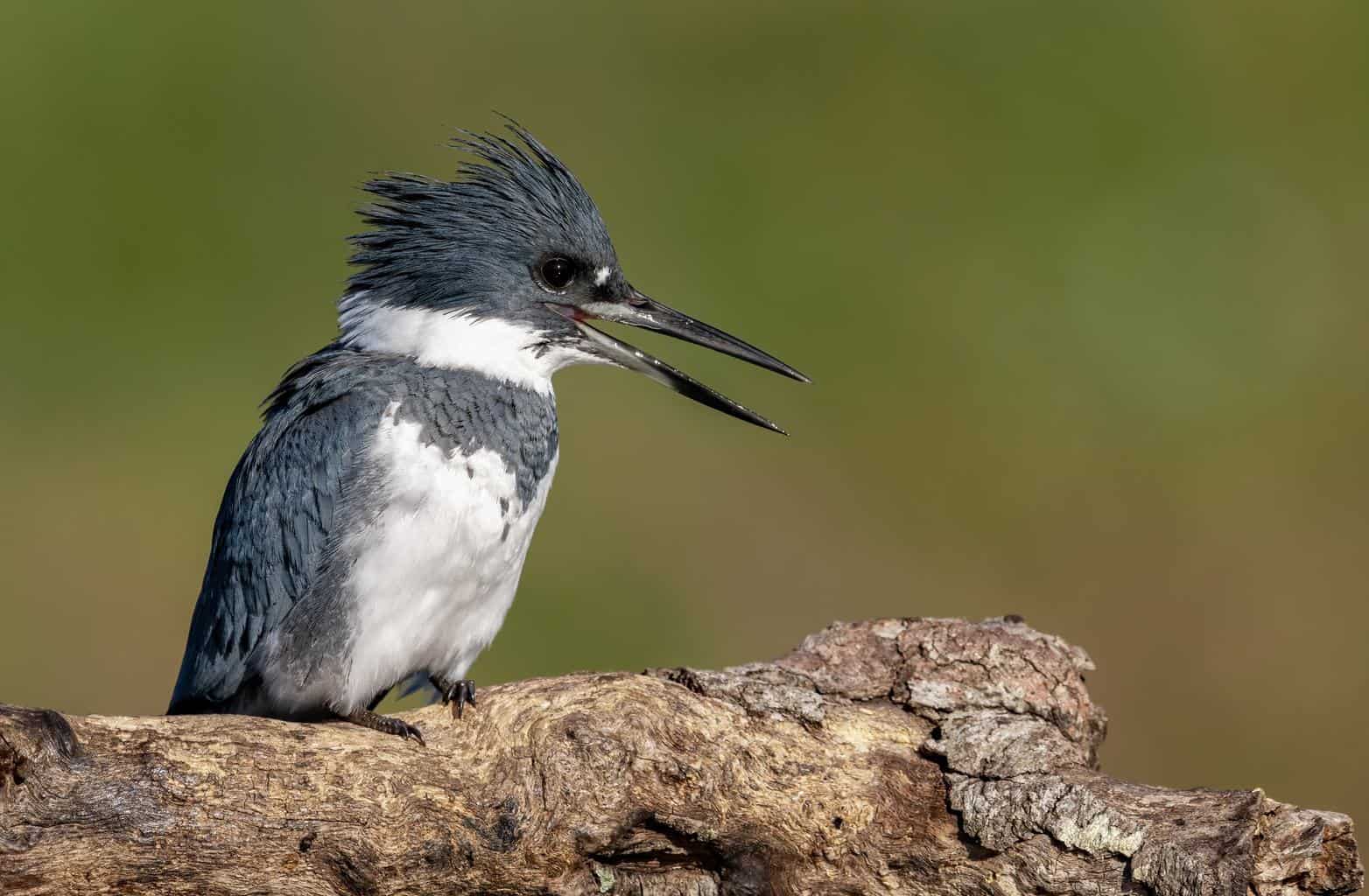
- Scientific Name: Megaceryle Alcyon
- Length: Between 11 and 14 inches
- Weight: Between 4 and 6.3 ounces
- Wingspan: Between 19 and 23 inches
Additional Information:
In the waterways of Kansas, the Belted Kingfisher is usually heard before it’s seen. Unlike other bird species, the female bird is more of a distinctive color pattern than the male, where it has gray-blue plumage with white spots and a rusty band on the belly. Male birds are usually paler.
The Belted Kingfisher lives next to streams, and most of its diet is made of fish. Young birds have an acidic stomach to digest fish as a whole. When it’s time to leave the nest, the birds lose this ability and regurgitate pellets that contain fish skeletons.
During the breeding season, males and sometimes females become aggressive to establish their territories. It might visit your backyard if you have a goldfish pond, so you need to take care of your pet fish.
Green Birds in Kansas
Anna’s Hummingbird
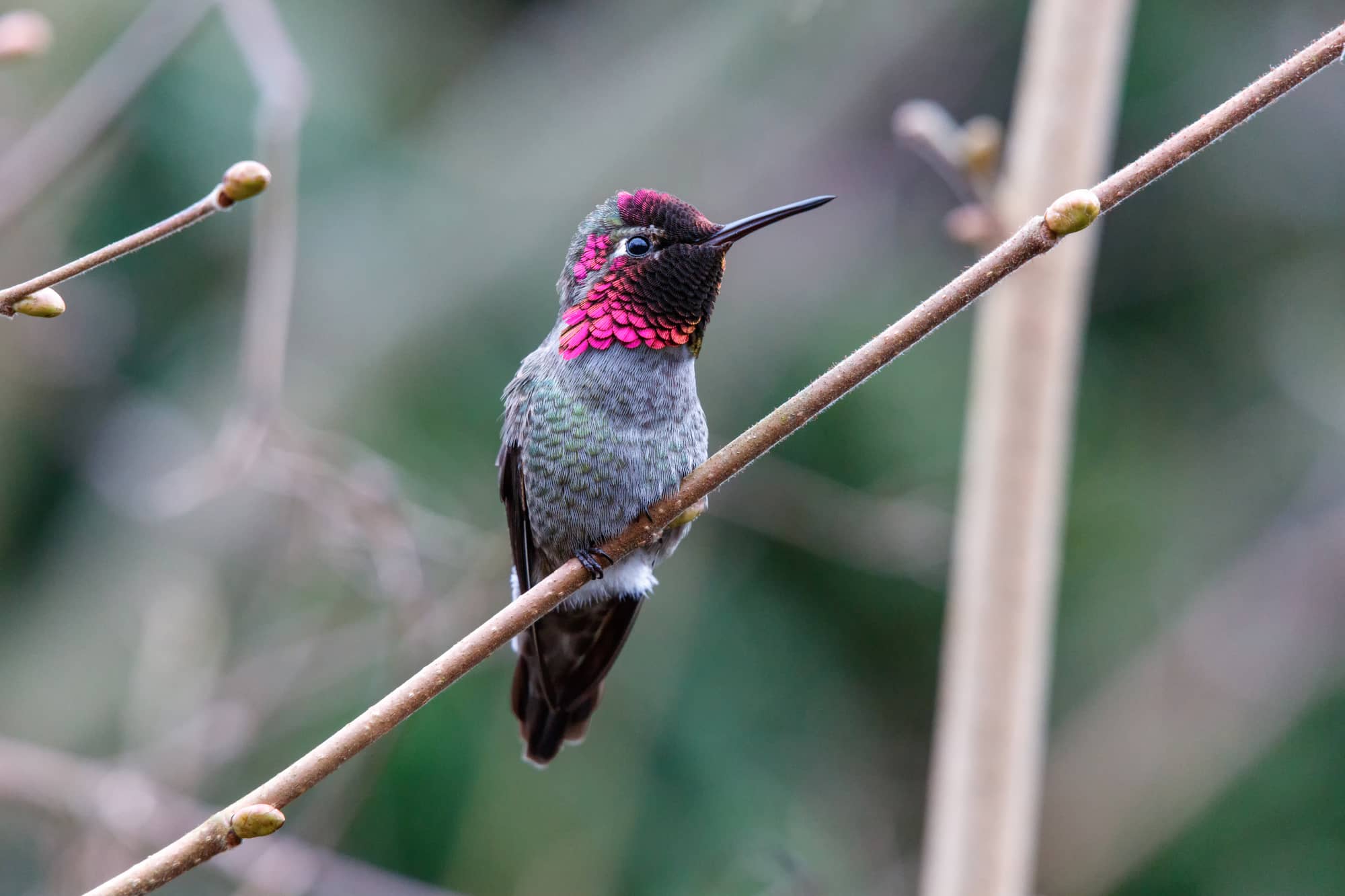
- Scientific Name: Calypte Anna
- Length: Between 3.9 and 4.3 inches
- Weight: Between 0.1 and 0.2 ounces
- Wingspan: About 4.7 inches
Additional Information:
Anna’s Hummingbird has an interestingly iridescent bronze-green back and an iridescent crimson-red crown that looks paler in the dark. Female birds look a lot paler and are smaller.
These small birds are quite noticeable as they are rather loud birds, especially during the breeding season, thanks to their courtship techniques. The male bird climbs up to 130 feet in the air, then swoops to the ground quickly while producing a loud noise using the tail feathers.
You can see Anna’s Hummingbird in your backyard if you set up a hummingbird feeder or grow bright blossoms during the spring. This bird doesn’t migrate much, so it might be a regular guest in your backyard all year long.
Violet-Green Swallow
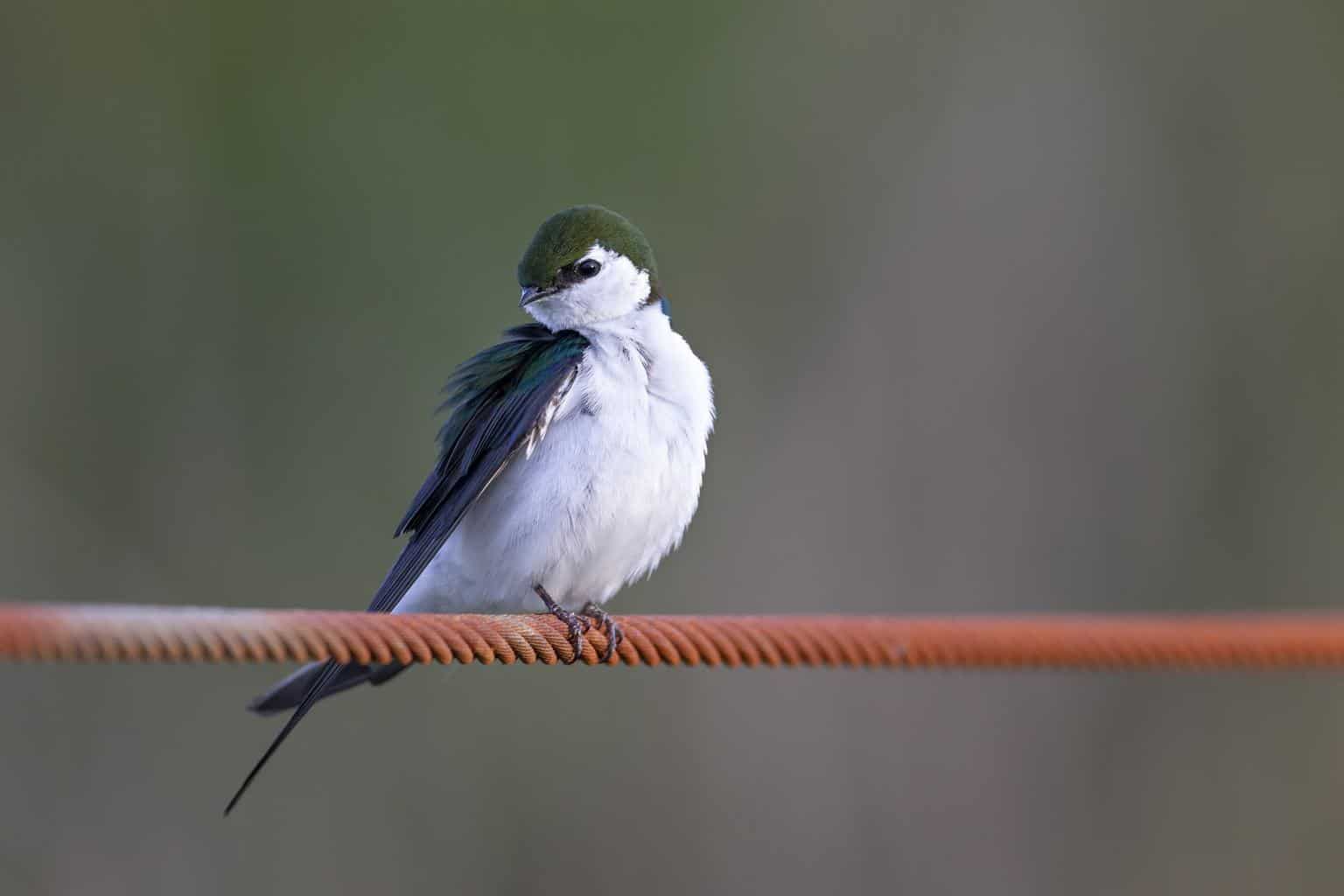
- Scientific Name: Tachycineta Thalassina
- Length: About 5 inches
- Weight: About 0.5 ounces
- Wingspan: About 10.6 inches
Additional Information:
Violet-Green Swallows have attractively iridescent bodies with violet rumps and green plumage, which appears more obvious in direct sunlight. In low-light conditions, the bird looks rather pale. Female and young birds have dusky cheeks, while males have white cheeks.
This bird is usually seen flying over water bodies and is seen with other swallows and swifts. It flies at high elevations and can be seen nesting close to buildings. Just like other swallows, the Violet-Green Swallow catches its insect prey while in flight. It eats flies, ants, beetles, and spiders.
The Violet-Green Swallows may visit your backyard if you set up a nesting box. You might want to consider setting up more than one box since this sociable bird likes to nest in groups.
Orange Birds in Kansas
Rufous Hummingbird
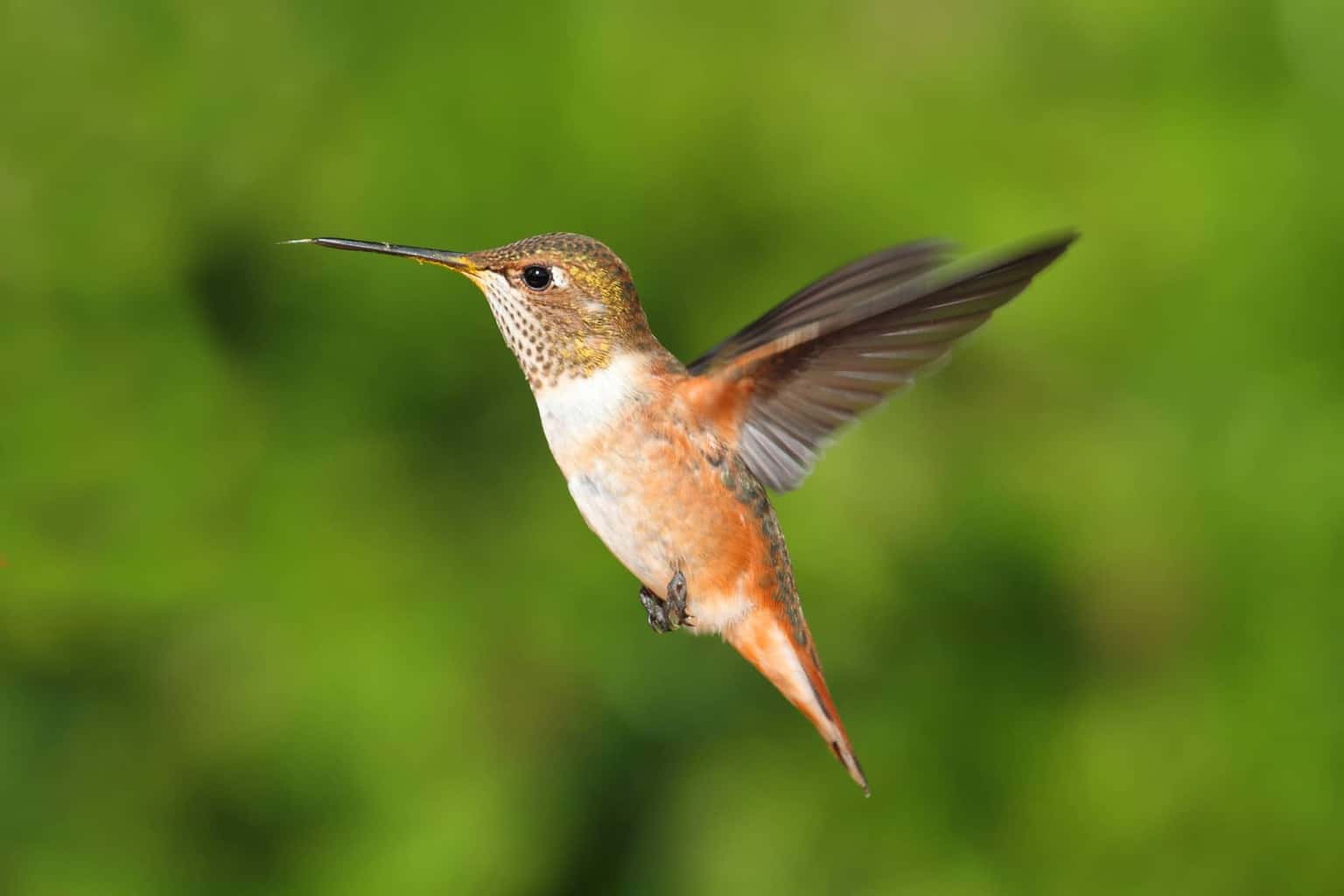
- Scientific Name: Selasphorus Rufus
- Length: Between 2.8 and 3.5 inches
- Weight: Between 0.071 and 0.176 ounces
- Wingspan: About 4.3 inches
Additional Information:
The Rufous Hummingbird has a bright orange back and belly, while females have green above and some rufous patches in the green tail. This bird needs to feed regularly to maintain its level of activity.
Your best chance to see this colorful bird is at flower-filled parks and backyards. It feeds on the nectar of tubular flowers but complements its diet with insects to provide it with fats and proteins. Males usually mate with several females.
Despite its small size, the Rufous Hummingbird is fearless, often chasing other hummingbirds at feeders. It can even chase bigger birds and rodents.
Allen’s Hummingbird
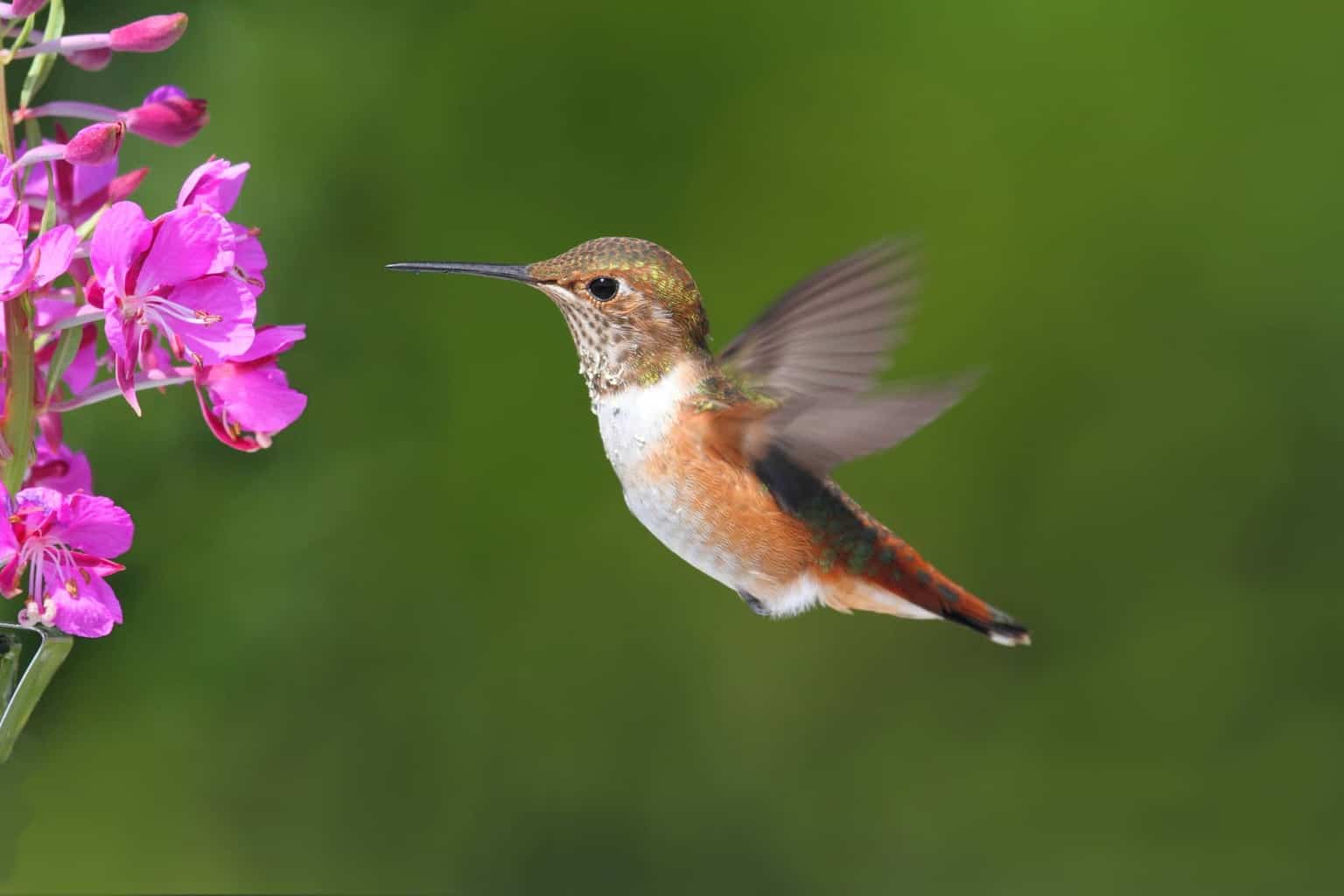
- Scientific Name: Selasphorus Sasin
- Length: Between 3 and 3.5 inches
- Weight: About 0.1 ounces
- Wingspan: About 4.3 inches
Additional Information:
Allen’s Hummingbird is coppery orange and green with a deep reddish-orange gorget. Female and young birds have paler sides. This bird hovers over flowers to drink the nectar. It also catches insects while they’re flying or snatches them from vegetation.
While flying back and forth, Allen’s Hummingbird moves like a swinging pendulum. The wings produce a bumblebee-like buzz due to their fast movement.
Set up a hummingbird feeder in your backyard, and prepare your own sugar water nectar by mixing one part of table sugar with four parts of water, but avoid adding food coloring.
Yellow Birds in Kansas
American Goldfinch
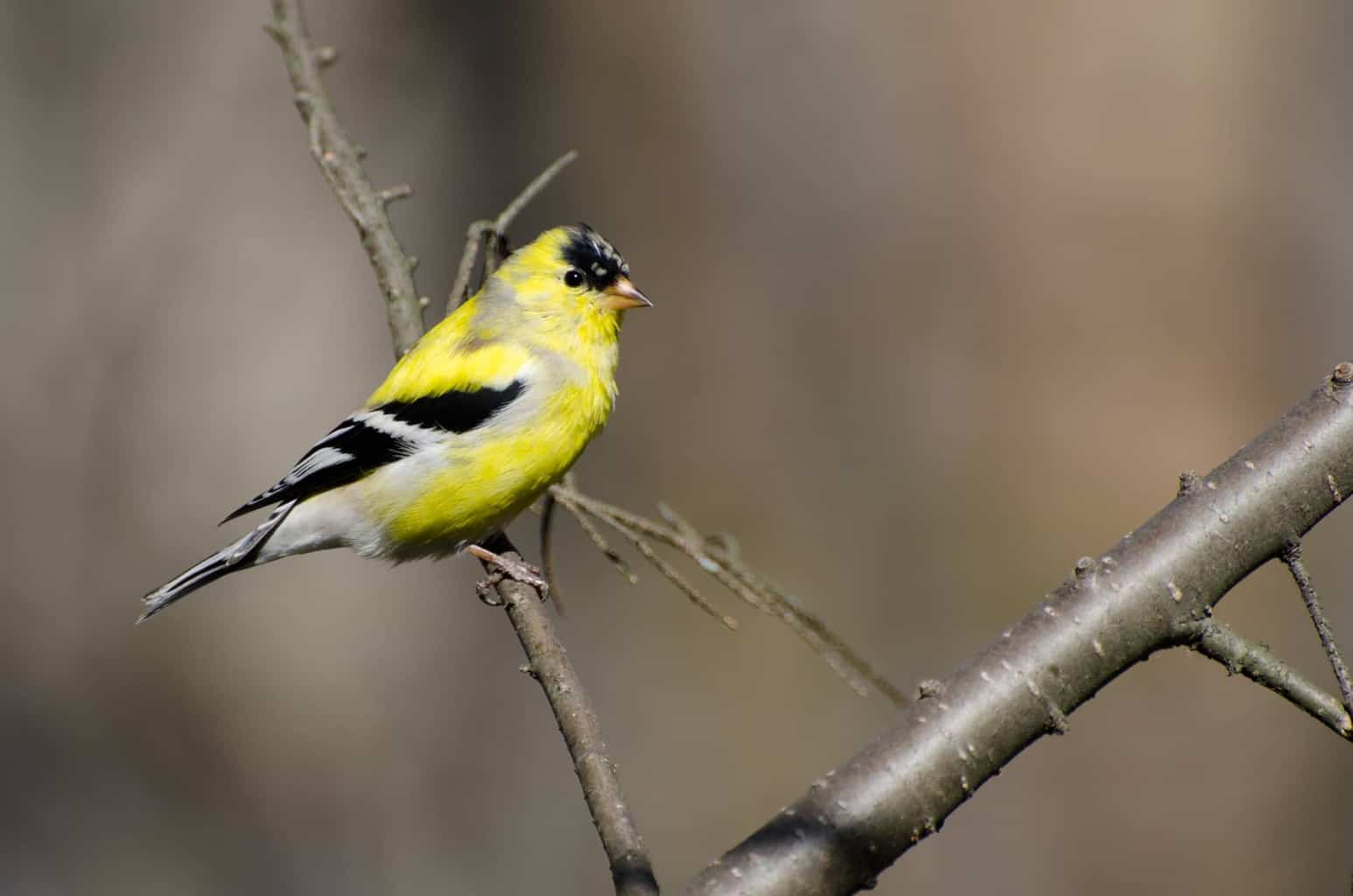
- Scientific Name: Spinus Tristis.
- Length: Between 4.3 and 5.5 inches.
- Weight: Between 0.39 and 0.71 ounces.
- Wingspan: Between 7.5 and 8.7 inches.
Additional Information:
The American Goldfinch can be found across Kansas, and it usually nests later than other songbirds. This bird has a bright yellow and black forehead and black wings with white markings. Female birds look a lot paler with their olive above and yellow underneath.
Known as a gifted acrobatic flyer, the American Goldfinch can be found in overgrown and weeding fields. It can also be found in parks and suburbs. It feeds on seeds and grass.
You can attract this bird to your backyard by planting thistles, as it’s known to cling to weeds and seed socks. Moreover, this bird visits feeders, so you can use sunflower seeds or Nyjer to attract it to your backyard.
Yellow-Bellied Sapsucker
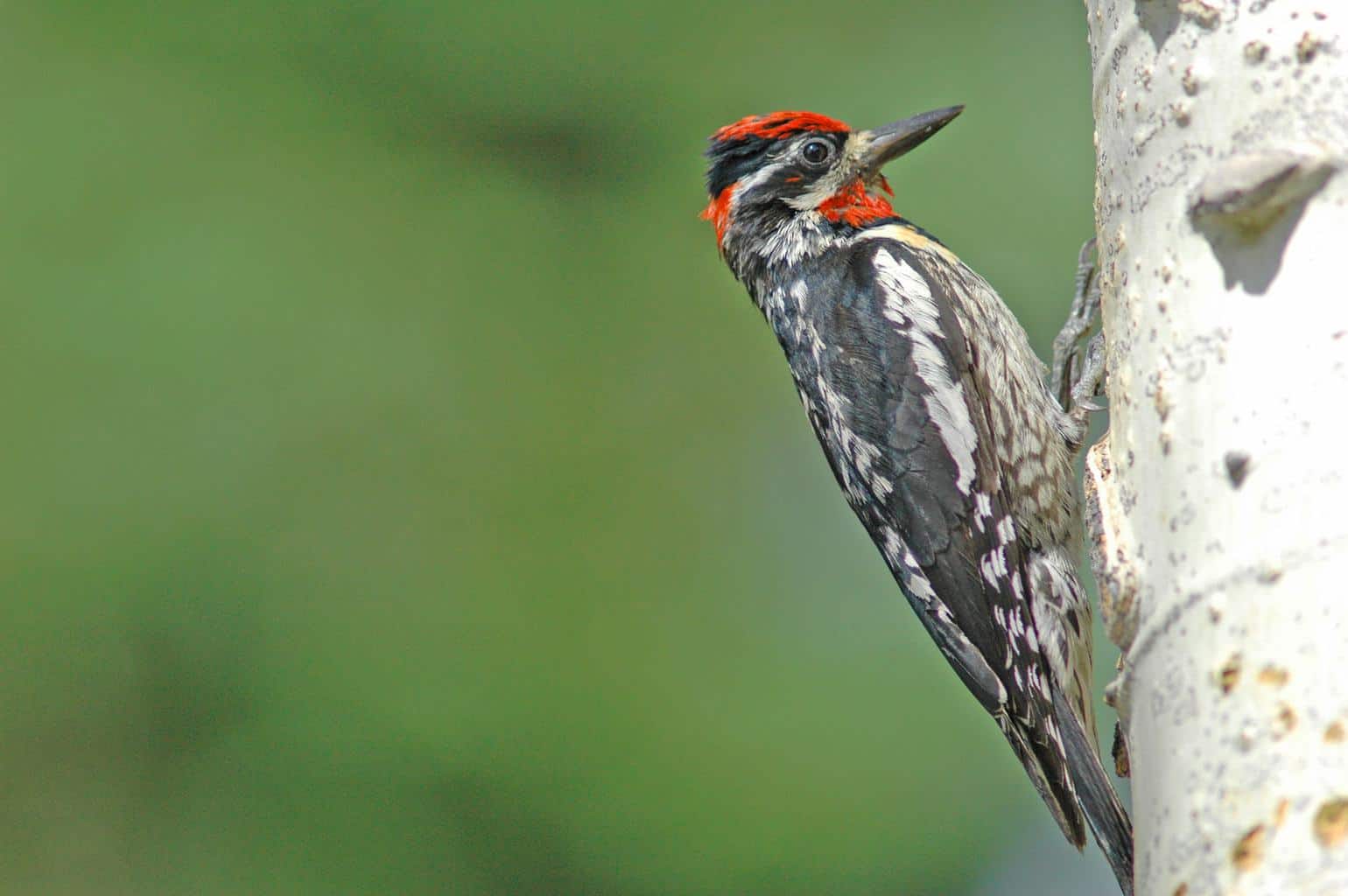
- Scientific Name: Sphyrapicus Varius
- Length: Between 7.5 and 8.3 inches
- Weight: Between 1.2 and 2.2 ounces
- Wingspan: Between 13.4 and 15.8 inches
Additional Information:
The Yellow-Bellied Sapsucker digs wells to lick the sap of trees and trap insects. It produces mewing calls and continuous drumming that makes it easy to identify.
This bird can be found in Kansas between October and April. It’s not a regular visitor of backyards unless you have a suet feeder. When it’s time to excavate a nest, it looks for trees that suffer from heart rot.
Western Meadowlark
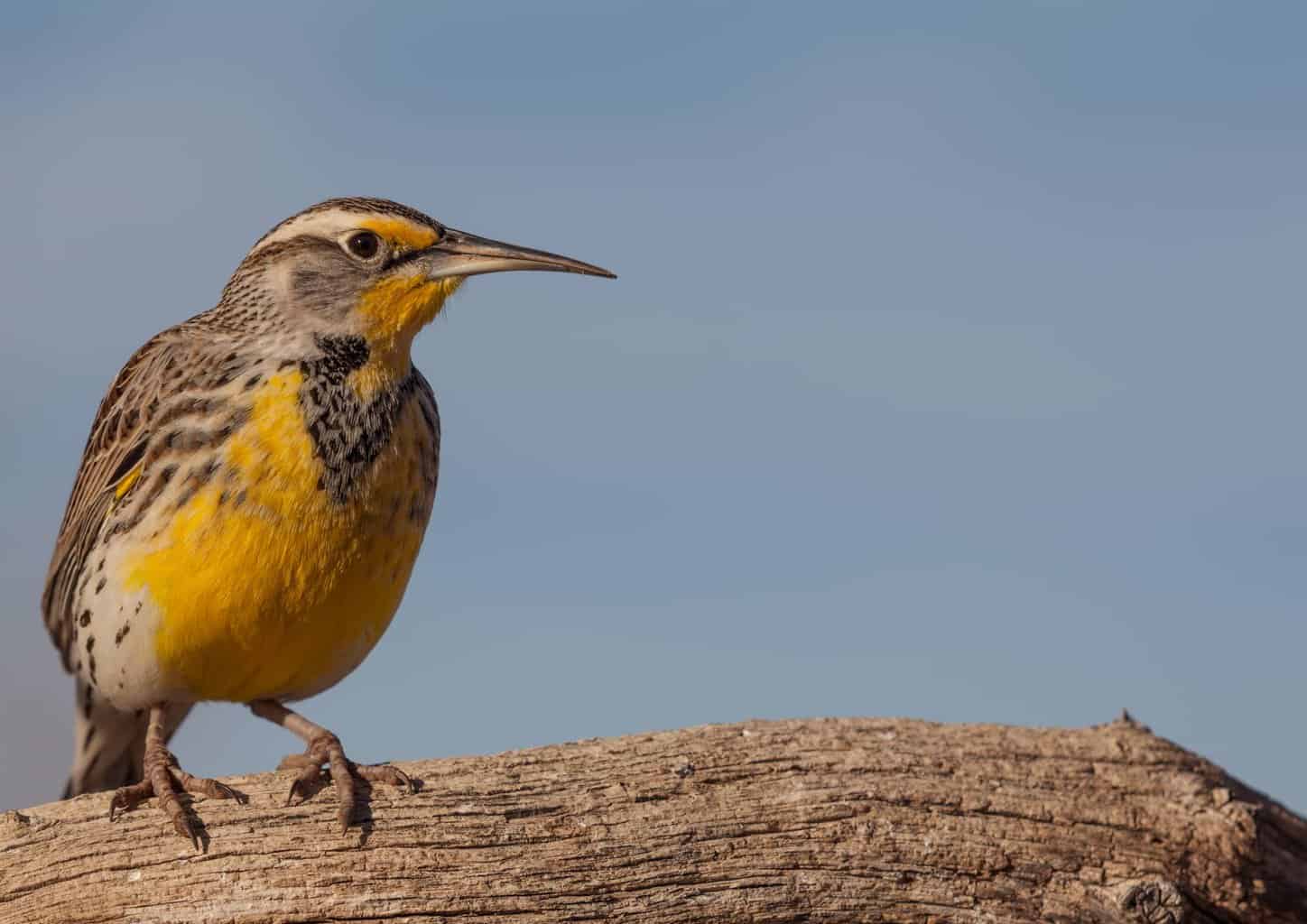
- Scientific Name: Sturnella Neglecta
- Length: Between 6.3 and 10.2 inches
- Weight: Between 3.1 and 4.1 ounces
- Wingspan: About 16.1 inches
Additional Information:
The Western Meadowlark has a pleasant flute-like melody, distinctive bright yellow plumage with a black V mark on the chest, and a patterned upper. It can often be seen foraging in fields of low vegetation.
It feeds on grain, weeds, and insects, alternating dietary patterns depending on the season. It can even feed on the eggs of other birds.
Other birds to Watch For in Kansas
Downy Woodpecker

- Scientific Name: Dryobates Pubescens
- Length: Between 5.5 and 7.1 inches
- Weight: Between 0.7 and 1 ounce
- Wingspan: Between 9.8 and 12.2 inches
Additional Information:
The small Downy Woodpecker has a small body, a blocky head, and a bill that looks smaller than the bills of other woodpeckers. It has a black body with a white belly and back, but it’s known for its checkered head. Males have a reddish color patch on their heads that the female birds lack.
Compared to larger woodpeckers, this one moves rather acrobatically. It can be found in the open woodlands in Kansas, in addition to orchards, city parks, vacant lots, and any backyard with seeds available.
It’s more likely to visit your backyard feeders than any other woodpecker in Kansas. Although it prefers feeders with suet feeders, it doesn’t mind black oil sunflower seeds, peanuts, and millet.
American Purple Gallinule
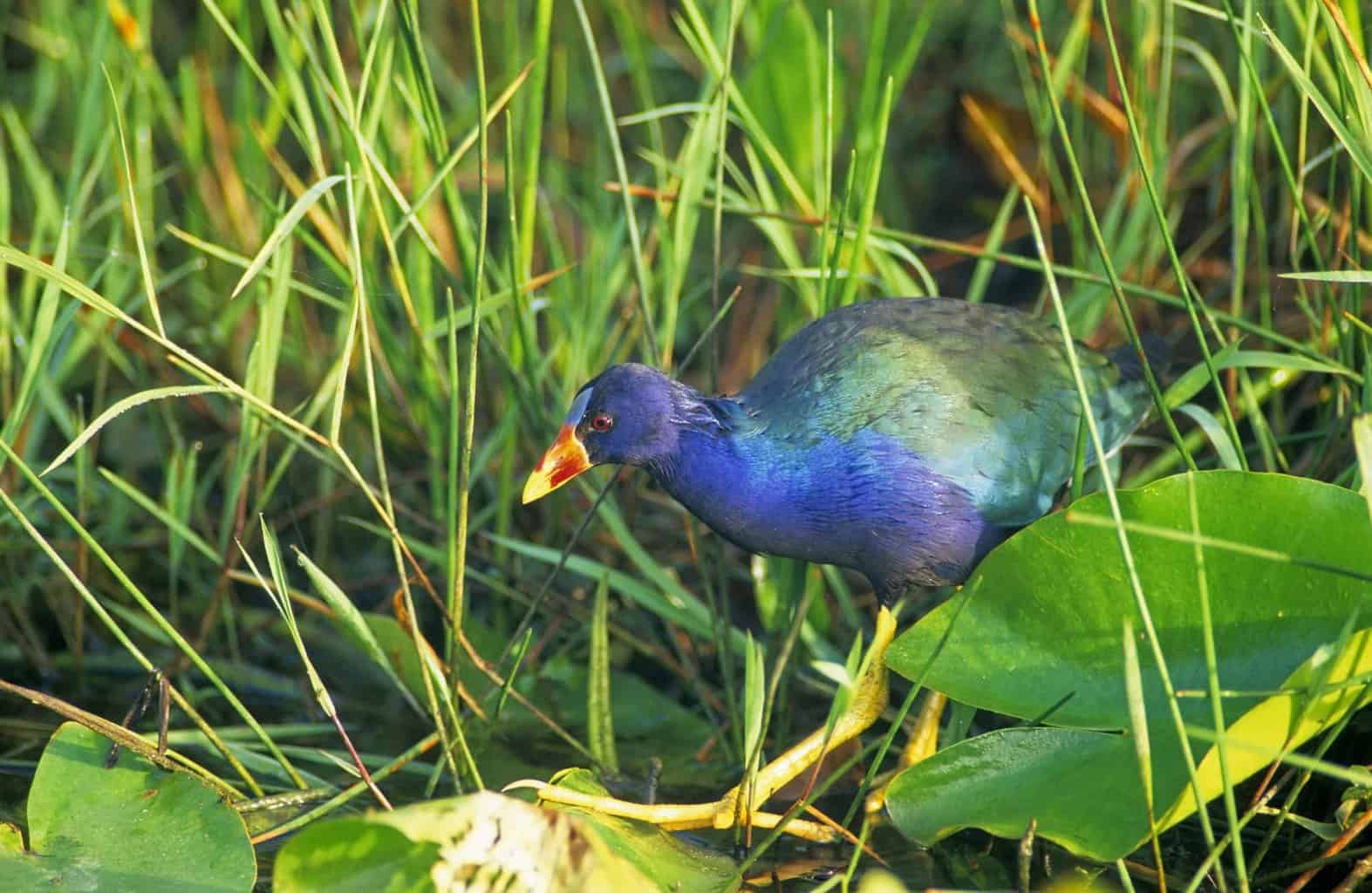
- Scientific Name: Porphyrio Martinicus
- Length: Between 10 and 15 inches
- Weight: Between 5 and 10.8 ounces
- Wingspan: Between 20 and 24 inches
Additional Information:
This bird can be found in marshes, stepping between water lilies and other water vegetation. Sky blue, moss green, yellow, red, and purple feathers blend incredibly to create the plumage of the American Purple Gallinule, making it one of the brightest birds that can be found in North America.
This chicken-sized bird has long legs and toes that allow him to forage near the water edge. It eats more plants than animals, usually feeding on the flowers and fruits of the water lilies and American lotus.
It occasionally feeds on spiders, beetles, and grasshoppers, as well as fish and eggs of other birds. Adults are territorial and usually produce loud calls during their fights.
Northern Harrier

- Scientific Name: Circus Hudsonius
- Length: Between 18.1 and 19.7 inches
- Weight: Between 10.6 and 26.5 ounces
- Wingspan: Between 40.2 and 46.5 inches
Additional Information:
The Northern Harrier is a medium-sized raptor that is usually recognized thanks to its slim body. The head is owl-shaped and helps the bird find mice and voles under vegetation, as it relies on its sense of hearing as well as its strong vision.
The Male Northern Harriers have gray heads and uppers and whitish below with black wingtips. Female and young birds have rather brown heads and bodies. The bird forages on the wing, usually flying low, feeding mostly on voles, as well as deer mice, shrews, house mice, and even rabbits.
The male can have as many as five mates at the same time, although in most cases, it usually has only two. Nest predators include the horned owl, raccoon, American crow, and feral dogs.
Cliff Swallow
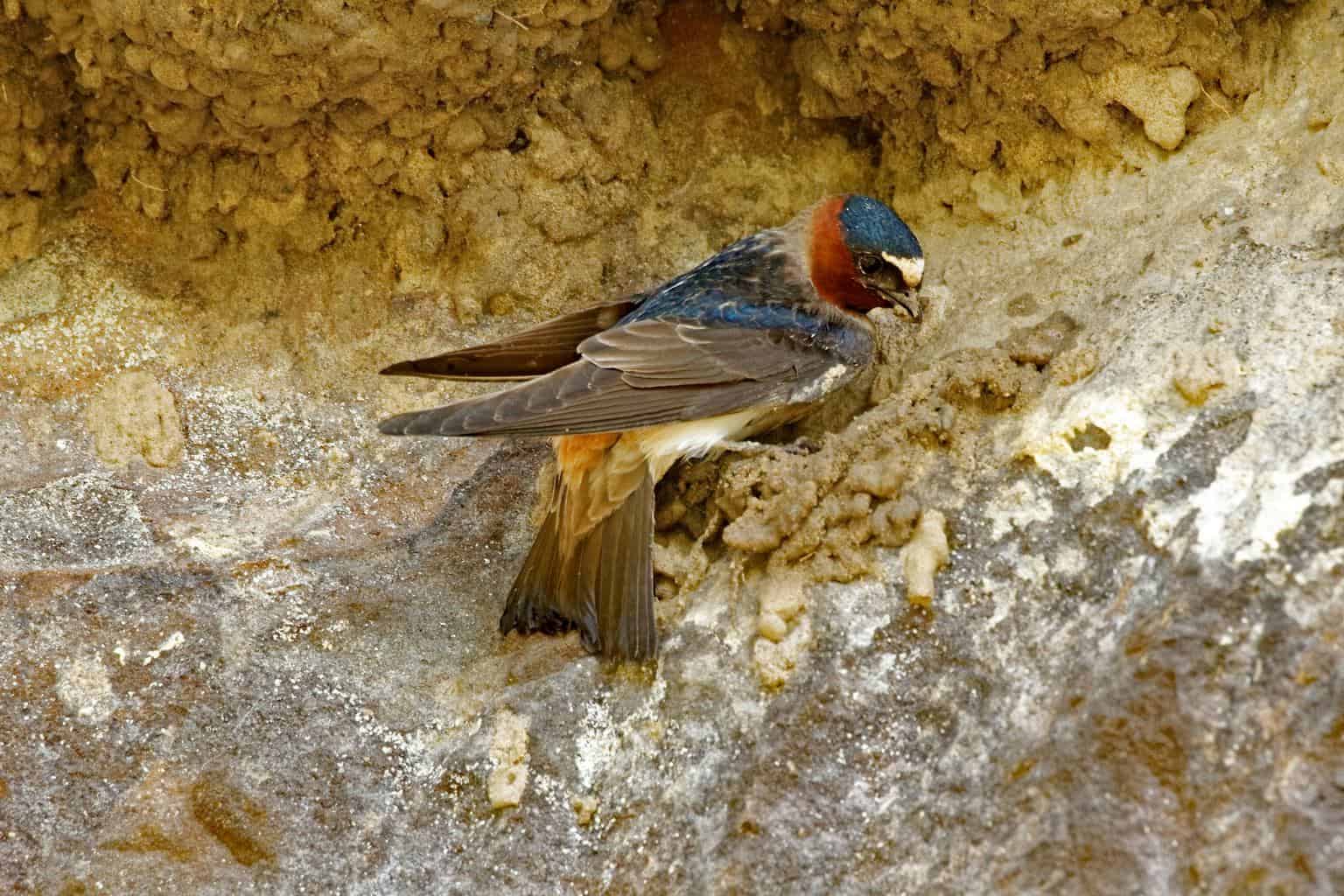
- Scientific Name: Petrochelidon Pyrrhonota
- Length: About 5.1 inches
- Weight: Between 0.67 and 1 ounce
- Wingspan: Between 4.15 and 4.39 inches
Additional Information:
The Cliff Swallow is a compact brown bird with a dark color at the throat, and whitish underneath. It forages in groups of up to 100 birds at a time and catches flying insects all year long. When birds fail to find food, they follow others to new foraging sites.
The Cliff Swallow is usually seen around bridges. You can find this bird by looking for its unique gourd-shaped mud nests.
Great Horned Owl
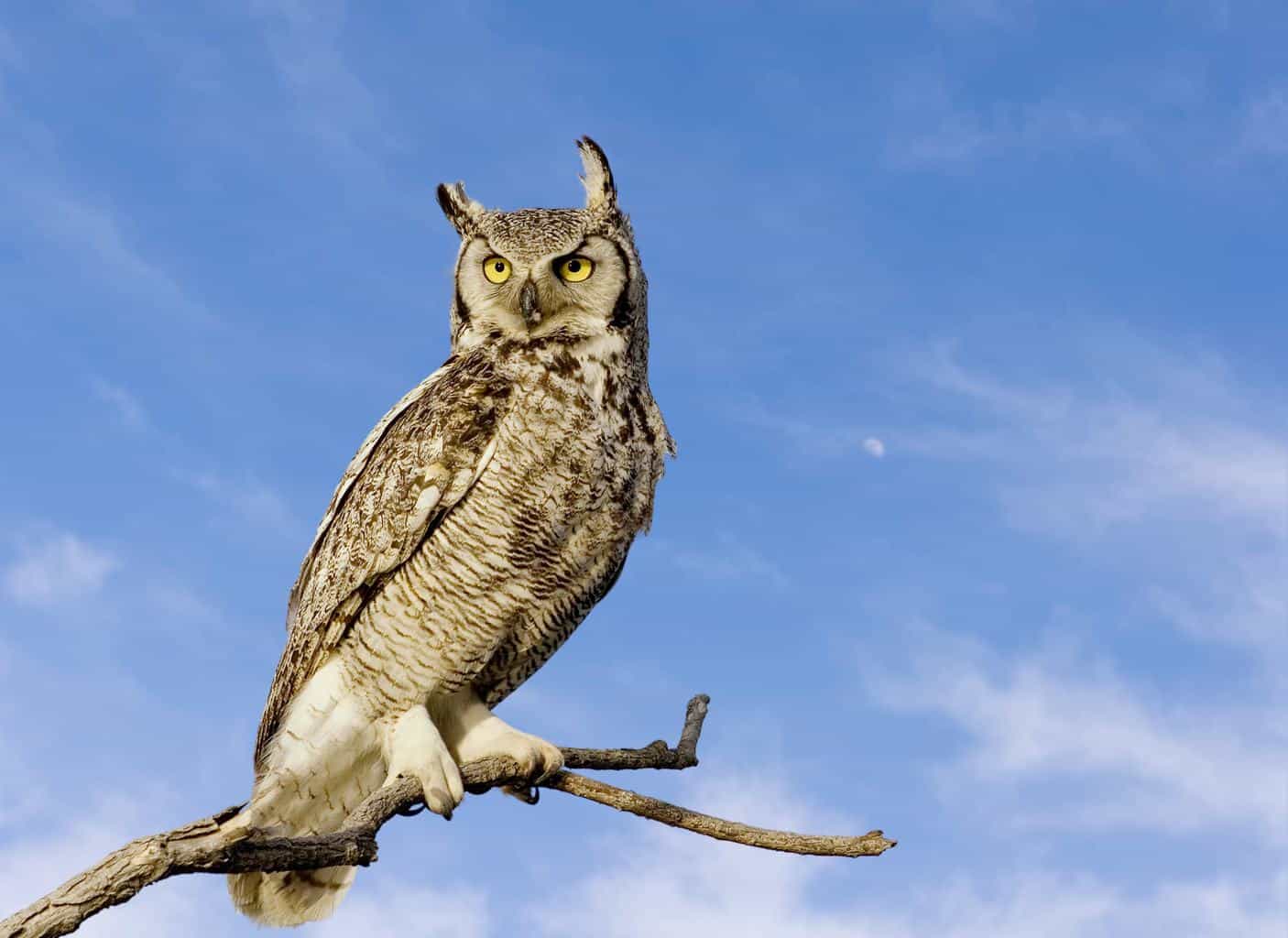
- Scientific Name: Bubo Virginianus
- Length: Between 17 and 25 inches
- Weight: Between 32 and 88 ounces
- Wingspan: Between 3 feet and 5 feet
Additional Information:
The Great Horned Owl can build its nest anywhere in Kansas as long as there are trees and rocky nesting sites. It has mottled gray-brown plumage with a barred underside. This body provides the perfect camouflage when the owl is perching.
As one of the biggest birds of prey, the Great Horned Owl feeds on small mammals, ducks, owls, hawks, and doves. Unlike other owls, this one can feed on skunks that other owls can’t tolerate because of its weak sense of smell.
Black-and-white Warbler
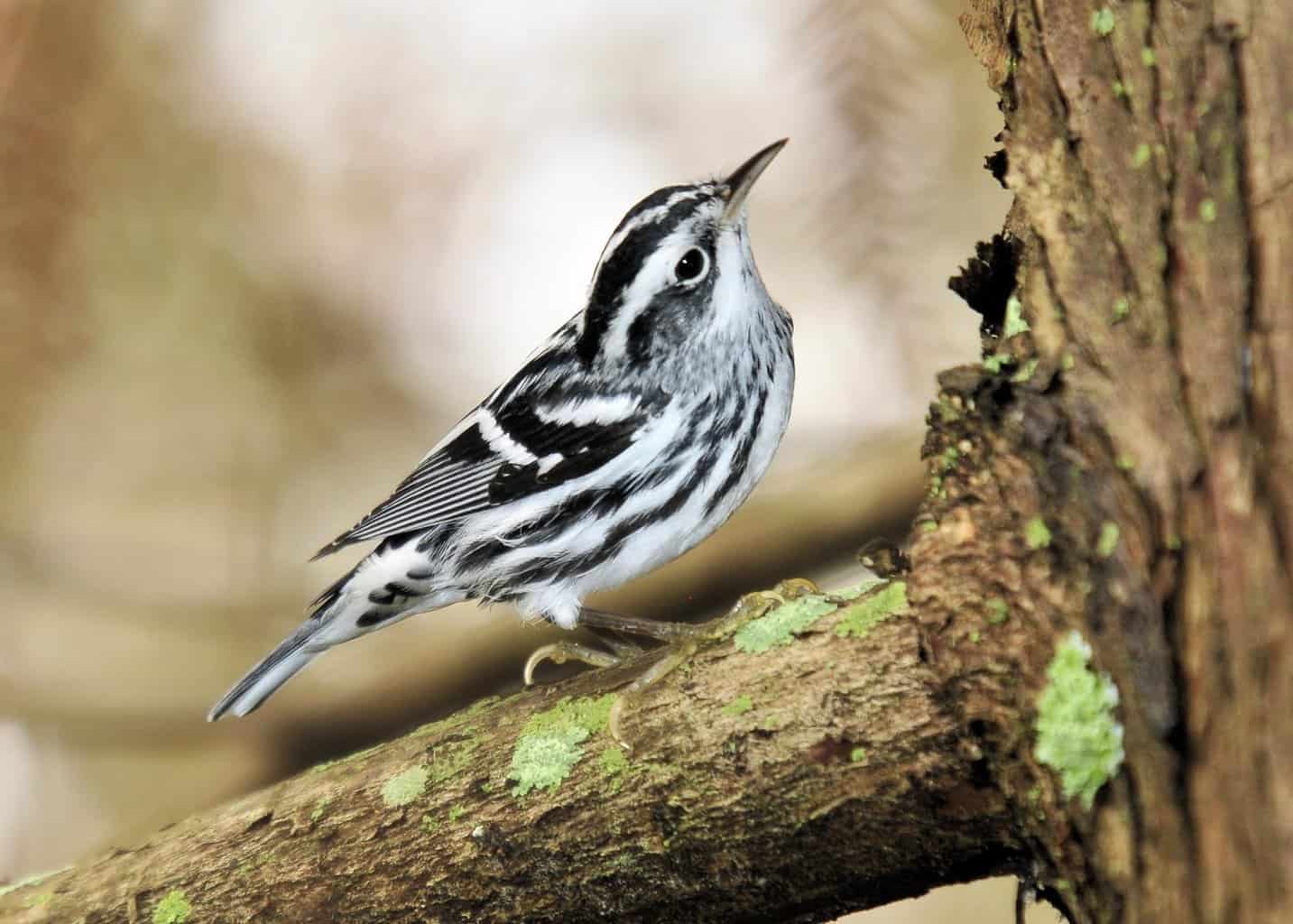
- Scientific Name: Mniotilta Varia
- Length: Between 4.3 and 5.1 inches
- Weight: Between 0.28 and 0.53 ounces
- Wingspan: Between 7.1 and 8.7 inches
Additional Information:
As the name suggests, this bird has black and white plumage, and its thin, squeaky, warbling song is usually the sign that the return of spring is here. It’s a highly competitive bird that usually fights with other species that enter its territory.
It can be found in various habitats, including gardens, fruit orchards, and lawns. The Black-and-White Warbler forages, looking for hidden insects in the bark of trees.
Purple Martin
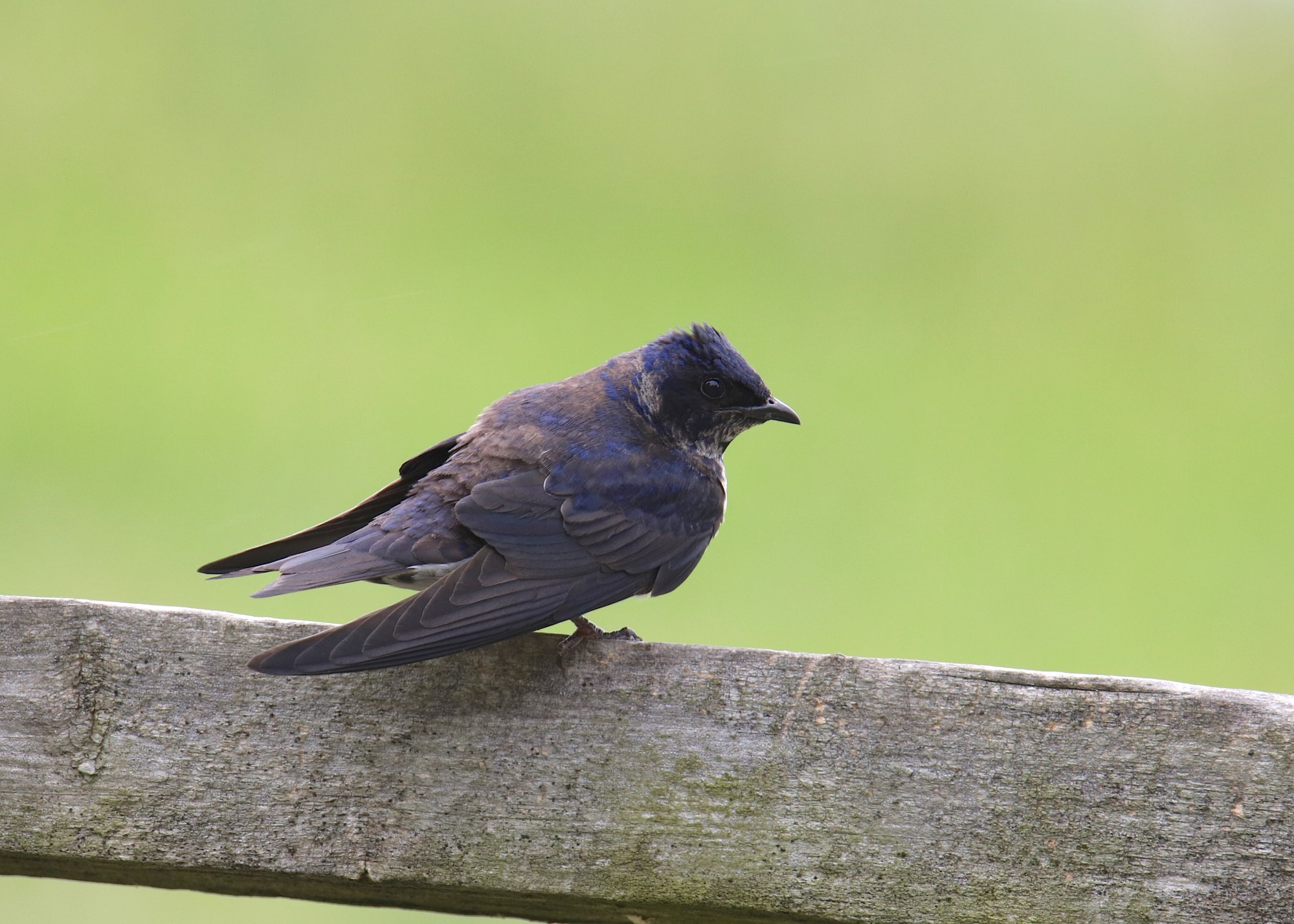
- Scientific Name: Progne Subis
- Length: Between 7.5 and 7.9 inches
- Weight: Between 1.6 and 2.1 ounces
- Wingspan: Between 15.3 and 16.1 inches
Additional Information:
The Purple Martin is a big swallow that can be found throughout Kansas, although it nests exclusively in man-made nests. It has bluish-purple plumage with brownish-black wings.
This bird flies fast and usually feeds on large insects while they’re flying. Purple Martins usually nest together and are seen foraging over towns, cities, parks, and open fields.
Conclusion
The time you spend in Kansas is a great opportunity to witness lots of its amazing birds and study their unique behavior. So, stay alert, and you might encounter some of them on your upcoming trip.

